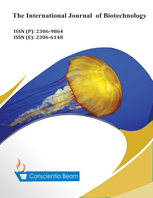Escherichia Coli Encoding Extended-Spectrum Beta-Lactamases Isolated from Diarrheic Patients in Minna, Nigeria
DOI:
https://doi.org/10.18488/journal.57.2021.102.52.68Abstract
Escherichia coli remains one of the most isolated etiological agents of diarrhea, accounting for more than 1 million deaths and about 4% of the total global disability-adjusted life-years (DALYS) per year across all age groups according to the global disease burden. This study evaluated multidrug-resistant Escherichia coli encoding extended spectrum beta-lactamases isolated from diarrheic patients in Minna, Nigeria using standard microbiological methods. A prevalence of 37.7% of Diarrheagenic E. coli (DEC) was obtained from the stool samples evaluated. Within the environment sampled, age group 21 – 30 years had the highest E. coli isolation rate (27.8%) while age group ≥71years had the least E. coli isolation rate (2.6%). Females (64.9%) were the most affected compared to males (35.1%). The isolates were significantly resistant to most of the beta-lactams tested especially to 3rd generation cephalosporins [Cefotaxime (98.2%), cefuroxime (93%), ceftazidime (84.2%), Augmentin (70.2%), Amoxicillin (59.6%)]. Resistance to other classes of antibiotics was also observed in varying percentages. A high percentage (98.2% and 87.7%) of the diarrheagenic E. coli had a multiple resistant index (MARI) ≥ of 0.3. The isolates had varying patterns of resistance with 47.6% resistant to more than 5 classes of antibiotics tested and produced ESBL characteristics phenotypically. Molecular evaluation showed that 40%, 50%, and 90% of the isolates harbored the OXA, CTX-M and TEM genes respectively while 50% harbored VEB and PER genes. This study isolated E. coli from diarrheic patients with multidrug resistance profiles and encodes more than one type of ESBL gene within Minna, Nigeria.

